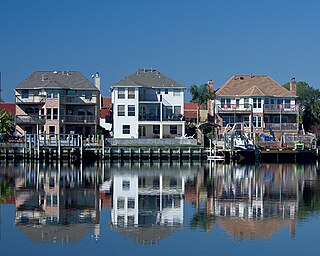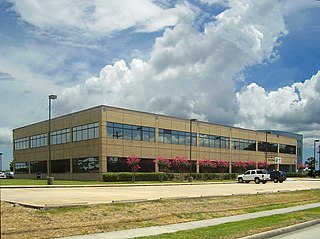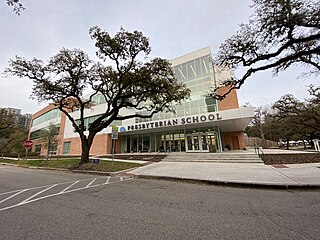
El Lago is a city in Harris County, Texas, United States. The population was 3,090 at the 2020 census.

Nassau Bay is a city in Harris County, Texas, United States, bordering the outermost southeastern edge of the city of Houston. It is located in the Clear Lake Area near Galveston Bay, directly adjacent to the Lyndon B. Johnson Space Center. The population was 5,347 at the 2020 census.

Pasadena is a city in the U.S. state of Texas, located in Harris County. It is part of the Houston–The Woodlands–Sugar Land metropolitan area. As of the 2020 U.S. census, the city's population was 151,950, making it the twentieth most populous city in Texas and the second most populous in Harris County. The area was founded in 1893 by John H. Burnett of Galveston, who named the area after Pasadena, California, because of the perceived lush vegetation.

Webster is a city in the U.S. state of Texas located in Harris County, within the Houston–The Woodlands–Sugar Land metropolitan area. Its population was 12,499 at the 2020 U.S. census.

Pearland is a city in the U.S. state of Texas, located in Brazoria County, with portions extending into Fort Bend and Harris counties. The city of Pearland is a principal city within the Houston–The Woodlands–Sugar Land metropolitan statistical area. At the 2020 U.S. census, the city's population was 125,828, up from a population of 91,252 at the 2010 census. Pearland's population growth rate from 2000 to 2010 was 142 percent, which ranked Pearland as the 15th-fastest-growing city in the U.S. during that time period, compared to other cities with a population of 10,000 or greater in 2000. Pearland is the third-largest city in the Greater Houston area after Houston and Pasadena, Texas.

Seabrook is a city in Harris County, Texas, United States, with some water surface area located within Chambers County. The population was 13,618 at the 2020 U.S. census. Several fish markets line the city's waterfront, while antique shops and bed and breakfast establishments are found in the city's downtown area. The city is home to several miles of trails, which connect multiple city parks to each other.

Clear Lake City is a master-planned community located in southeast Harris County, Texas, within the Bay Area of Greater Houston. It is the second-largest master-planned community in Houston – behind Kingwood. The majority of the community lies in the corporate limits of Houston, and a small eastern portion within the city limits of Taylor Lake Village.

The Houston Museum District is an association of 19 museums, galleries, cultural centers and community organizations located in Houston, Texas, dedicated to promoting art, science, history and culture.

The following is an alphabetical list of articles related to the U.S. state of Texas.

Clear Lake, or the Clear Lake Area, is a region in parts of Harris and Galveston County in Texas, United States. It is part of the Galveston Bay Area, which itself is a section of the Houston–The Woodlands–Sugar Land metropolitan area. The area is geographically characterized by the bodies of water in it and around it, including Clear Lake, Taylor Lake, Clear Creek, and Galveston Bay.

Clear Creek Independent School District (CCISD) is a school district based in League City, Texas, United States. The district serves most of the Clear Lake Area and some other neighboring parts of the Houston metropolitan area. CCISD is the 29th largest school district in Texas, spanning 103 square miles and serving over 41,000 students. The district operates 45 distinct campuses, consisting of 5 comprehensive high schools, 3 alternative high schools, 10 intermediate schools, and 27 elementary schools. The Superintendent of Schools is Karen Engle.

Clear Lake High School is a public secondary school located in Houston, Texas, United States.

Tranquillity Park is a municipal park in Houston, Texas.
Grace Church Houston is a non-denominational located in Houston, Texas.

Presbyterian School is a private, coeducational Christian PreK-8 day school in the Museum District, Houston. Presbyterian School is composed of three divisions: an Early Childhood division, Alpha through Pre-kindergarten, a Lower School division, Kindergarten through grade four, and a Middle School division, fifth through eighth grade.

First Presbyterian Church of Dallas is a historic congregation at 1835 Young Street in the Farmers Market District of downtown Dallas, Texas (USA). The current building is a contributing property in the Harwood Street Historic District and a Dallas Landmark. The congregation was founded in 1856 as the first U.S. (Southern) Presbyterian Church organized in Dallas, and is the mother church from which many other Presbyterian churches in the area have stemmed.

The Galveston Bay Area, also known as Bay Area Houston or simply the Bay Area, is a region that surrounds the Galveston Bay estuary of Southeast Texas in the United States, within Houston–The Woodlands–Sugar Land metropolitan area. Normally the term refers to the mainland communities around the bay and excludes Galveston as well as most of Houston.

Harry Daniel Payne (1891–1987) was an American architect and engineer; protégé of noted St. Louis Architect, William Ittner. Payne is most known for building designs in the U.S. State of Texas after 1926, but before this as a member of the Ittner Firm, he designed schools and hospitals in other states. Payne was born in St. Louis, Missouri, and was trained at Washington University in St. Louis. Upon graduation, he attended Fort Sheridan Officers Training School, and served in World War I in Company H, 320th Infantry, 80th Division. On September 25–26, 1918 he fought in the Meuse-Argone Offensive, leading men of H Company to take Dead Man's Hill. Payne received a battlefield commission to Captain just before the Armistice. He returned to St. Louis after the war to work with the Ittner form until 1926. That year he was recruited by Houston School Board to design all new schools for the city. After this contract was completed he went on to design schools, jails, office buildings, stadiums, houses and museums in Texas including for Anahuac ISD, Beaumont ISD, Corpus Christi ISD, Houston ISD, and Huntsville ISD.

For a period of over 7000 years, humans have inhabited the Galveston Bay Area in what is now the United States. Through their history the communities in the region have been influenced by the once competing sister cities of Houston and Galveston, but still have their own distinct history. Though never truly a single, unified community, the histories of the Bay Area communities have had many common threads.

The First Presbyterian Church is a church in the Museum District of Houston, Texas. As of 2012 it had 3,567 members. The church has been located in the Museum District since 1948.


















